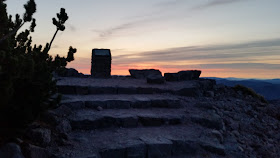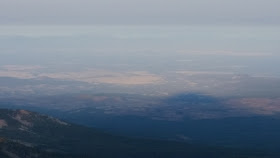 |
| Sunrise from Lassen Peak, with Reading Peak on the right. |
 |
| Lassen Peak from Manzanita Lake the day before. |
The temperature stayed about the same during the entire half-hour drive 2,500' up to the gigantic trailhead parking lot at 8,500'--I was glad, since I was expecting it to cool down about 10 degrees F. There was one other car in the parking lot, and as I got out of my car, another vehicle swooped into the parking lot quickly and stopped quickly nearby, pointing its headlights directly at the trailhead. They sat in their car--they were here for the cell phone service, best in the park. No wonder why the parking lot was so huge.
I started hiking up the trail in the dim light of the full moon. Sirius and Venus shone brightly in the southeast. Lights in the Sacramento Valley were visible. At the first switchback, a prominent sign warned visitors that the trail would be closed to all but guided tours if people kept cutting switchbacks. Hikers leaving the trail would be fined. After being closed for most of the last 6 years for repairs following the death of a child due to a collapsing wall on the trail, the National Park Service was serious about maintaining the trail in good condition and preserving a quality visitor experience.
 |
| The tightly restricted Lassen Peak area: stay on the trail! |
The trail was beautiful. The rock work was incredible. At each switchback, beautiful stone walls retained the slopes and trail. Elegant stone steps led to dramatic views beyond well-crafted interpretive signs perched atop stone monuments. And sunrise made it even more beautiful.
 |
| The Park Service did an amazing job on this trail. |
 |
| The sun lighting up the atmospheres of Earth and Venus. |
The sun rose at 6:30 a.m, bathing the east slopes of the mountain in dim orange light. The wind was from the west at about 30 mph with gusts to 40 mph, and strengthened as I climbed higher on the mountain. Because the trail followed the south ridge most of the way, the microclimate on either side of the ridge was dramatically different. I would be hiking in the strong wind, and come over the ridge into the brightening sunlight on the eastern side, and the wind would almost stop in the lee of the ridge. Then a switchback would bring me back over the ridge to the west, and I would brace myself for another wind-whipped couple of minutes in the dim morning shadow of the ridge.
On the east side of the ridge, where it was calm, you couldn't feel the wind, but you could hear it. Without anything else to blow against, it was the sound of wind on rock. It is a familiar sound to desert travelers: the sound of an approaching gust, the sound of a dust devil swirling in the dirt, the sound of the air blowing against itself and the bare earth, the sound of wind on the other side of a ridge, or around a bend in a canyon, or just outside a cozy cave. It is a sound that isn't as loud as the buffeting wind against your ears, so you have to be out of the wind, but near enough, to hear it. And to hear it--most important of all--you must be in a quiet place, away from human noise. Where the wind is the loudest thing, you know you have found a special place.
As I reached the top at 7:00 a.m., I passed interpretive signs informing me that this was the youngest rock in California--and this would be true, if it weren't for tufa in Mono Lake that is forming daily. Lassen Peak, one of the world's largest plug-dome volcanoes, erupted in May and June 1915, exactly 100 years ago. The 100-year-old rocks were the youngest igneous rocks I had ever seen. One interpretive sign quoted a man who was on the summit in June 1915 and fled down the mountain as an eruption started, pelting him with small rocks, and one twice as big as his fist knocked him down. He apparently lived to be quoted.
A Stonehenge-like arrangement of pillars supporting interpretive signs surrounded a boulder at the top, like some mystical religious monument. A cordoned off area set aside for rare plants had me wondering where those plants came from after the eruption--refugia on the mountain, or were they brought from elsewhere by birds or wind? What a volcanic eruption can't eradicate, many hundreds of hiking boots can.
 |
| The views at the top, just a half hour after sunrise, were superlative. |
 |
| Mount Lassen's shadow eclipsing the Sacramento Valley. |
The views from the top were superlative. Except the view of Mt. Shasta, marred by the Hatchet Ridge Wind Farm just west of Burney, where forty-four 418-foot tall wind turbines were built in 2010. The view from Mt. Shasta looking at Lassen Peak must be equally depressing--how did this location, directly in the line of sight between California's two largest volcanoes, seem like a good idea for a wind farm? And more wind farms may be coming, making this remote part of Northern California look more like Southern California--adding one more place to the list of places to not go if you want to go someplace that looks different than where you came from.
 |
| Moneymaker: $200 million wind farm in front of Mt. Shasta's lower slopes, visible below the clouds. |
 |
| A refreshingly-small trail led down into the crater, and over to the
highest point, where an obelisk housing a seismograph and transmitter had been removed. |
I left the top, and reached my car in about 45 minutes. Like last year, after my early morning adventure, I stopped at King's Creek and jumped in, but unlike last year there was no frost on the meadow--this time it was an hour later in the morning and the windy night had mixed the atmosphere. The painfully cold and refreshing water was energizing. The sound of wind on rock faded from memory as my attention turned to the world of human sounds.


Sounds like a great hike!
ReplyDelete